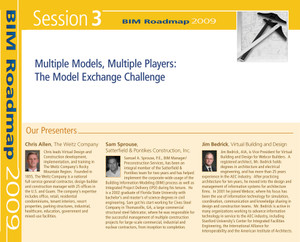Handoff, 30-yard pass or fumble? How is the data in the model made available to other members of the project team? Is the data transferred, loaned, exported or shared? What about keeping changes in sync? Who is responsible for maintaining the data and for maintaining the model? What happens when there are multiple models? These are the questions and challenges facing BIM users everyday, and this session will help you understand the mechanics of multiple parties that must share and work with the various models.
Why transfer models?
· Issues with data?
-- Protection of proprietary data
-- Sifting through extraneous data
-- Temporary construction data
· Developing new models for specific purposes
· Owner deliverables - multiple models or single consolidated model
· Future trends and opportunities
To answer these questions and more, we have assembled a team of experienced BIM professionals to relate their real-world experience on this key topic.
Your Speakers:
Chris Allen, Manager of Virtual Design & Construction, The Weitz Company
Chris leads Virtual Design and Construction development, implementation and training in The Weitz Company's Rocky Mountain Region. Founded in 1855, The Weitz Company is a national full-service general contractor, design-builder and construction manager with 25 offices in the U.S. and Guam. The company's expertise includes office, retail, residential condominiums, tenant interiors, resort properties, parking structures, industrial, healthcare, education, government and mixed-use facilities.
Bruce C. Cousins, AIA, Senior Manager of Virtual Design & Construction, The Weitz Company
Mr. Cousins is the Senior Manager of Virtual Design and Construction for The Weitz Company. He is responsible for the implementation of Virtual Design and Construction and BIM modeling for the company's eleven regional offices. He started with Weitz in 2007. The Company now has $1.7B project value and 41 construction professionals modeling and managing projects virtually. As a practicing Architect for over 30 years he specialized in resort planning and higher density mixed-use resort projects. He has presented University courses, published articles, conducted workshops and made presentations about the integration of technology in architecture practice and construction processes. Currently, He is integrating VDC-BIM and Lean techniques - Target Value Design and the application of VDC-BIM in the field. A registered Architect, Mr. Cousins has a Masters of Architecture from the University. of California Berkeley
Jim Bedrick, VP for Virtual Building & Design, Webcor Builders
A registered architect, Mr. Bedrick holds degrees in both Architecture and Electrical Engineering, and has more than 25 years' experience in the AEC industry. After practicing architecture for ten years, he moved into the design and management of information systems for architecture firms. In 1998 he joined 3Com Corporation, directing information technology for their worldwide construction and facilities management division. In 2001 he joined Webcor, where his focus has been the use of information technology for simulation, coordination, communication and knowledge sharing in design and construction teams. Mr. Bedrick is active in many organizations working to advance information technology in service to the AEC industry, including Stanfords Center for Integrated Facilities Engineering, the International Alliance for Interoperability and the American Institute of Architects, where he serves on the Board Knowledge Committee and is a major contributor to the Integrated Project Delivery effort.University'
Sam Sprouse, Satterfield & Pontikes Construction, Inc.
Sam has been an integral member of the Satterfield & Pontikes team for two years and has helped implement the corporate-wide usage of the Building Information Modeling (BIM) process as well as Integrated Project Delivery (IPD) during his tenure. As an employee with Satterfield & Pontikes, Sam oversees day-to-day usage of BIM technologies to improve the accuracy, velocity and documentation of the construction process. These efforts include creating virtual 3-D compiled models used in construction coordination as well as creating unique database assemblies used in preliminary estimating practices that are directly proportional to the information available in the progress model during a given phase of design.

